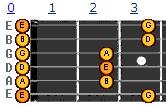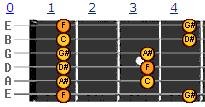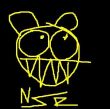| btimm |
|
|
Joined: 14 Dec 2009 United States  Lessons: 2 Licks: 1 Karma: 16 
|
I have a couple of questions on scales. I don't have my guitar with me, since I am at work, but still taking a break to learn anyways, lol. I digress ...
I know the basic part of the E Minor Pentatonic Scale. I am not sure why I know this part, maybe because I very vaguely remember a friend showing it to me when I was younger, maybe because of "Hey Joe", not sure. I know the part below:

I know if I shift it up 12 frets, it keeps the same pattern. I also noticed if I moved it around the fretboard, it still sounded "right". So I checked today and sure enough if I move it up 1 fret, it becomes E instead of F:

How cool is this right? So I have a few questions basically.
1) When I learn the middle patterns to the E Pentatonic Scale, will I then know every key simply by shifting the patterns along the fret board?
2) Do all scales follow this pattern? Not the exact pattern of the pentatonic scale, but what I mean is, if I learn any scale in one key and simply shift it, will I know that scale for all keys by moving along the neck like I noticed with E and F Minor Pentatonic scales?
3) I could check when I get home, but I am curious at work. lol How do I move between the patterns for a scale? For E Minor Pentatonic for example, after I play the first pattern and I get to the G on the e string, where would I go from there? Would I then go to the E string, 5th fret and play that A after the G on the e string? Maybe I just can't tell because I am not playing, but would that sound weird being a different octave?
4) Lots of questions I know. What are the best scales to learn if I want to play primarily rock and blues? I have heard minor pentatonic and blues pentatonic, but are there other good scales to learn for that sort of music as well?
Thanks for all the help! |
| AlexB |
|
|
Joined: 13 Jul 2009 Mexico  Licks: 2 Karma: 23 
|
1)Yes
2)Yes
3)You can do anything as long as you're on the scale and keep on it, and as long as it sounds good!
4) minor pentatonic and minor scale! |
| Guitarslinger124 |
|
|
Joined: 25 Jul 2007 United States  Lessons: 12 Licks: 42 Karma: 38  Moderator Moderator
|
I've found that it is much easier to understand all this funky scale stuff is to first learn the C major scale. I only say this because the C major scale contains no sharped or flatted notes.
The pattern for building any 'major scale' a.k.a. Ionian scale is as follows: Whole Step - Whole Step - Half Step - Whole Step - Whole Step - Whole Step - Half Step. This leads back to why I say to learn the C major scale, a.k.a. C Ionian. I can best explain it as follows:
The notes in the C Ionian Scale are C D E F G A B
W= Whole Step H= Half Step
W W H W W W H
/ \ / \ / \ / \ / \ / \ / \
C D E F G A B C
As you can see, to from C to D is one whole step (The equivalent of two frets on the fretboard), to go from D to E is also one whole step, but to go from E to F is one half step.
You can apply this pattern to any 'major' scale. Take G Ionian for example: G A B C D E F# G.
W W H W W W H
/ \ / \ / \ / \ / \ / \ / \
G A B C D E F# G
So to answer you ultimate question, yes; you can transpose the same pattern to different keys. Or in other words, each scale pattern is the same regardless of what key you are in. This is because one of the main things that define a scale pattern, are the intervals (i.e. whole steps and half steps) that are used, not the notes.
I hope that bettered your understanding of scales and answered your question. Good luck dude. |
| gx1327 |
|
|
Joined: 20 Sep 2009 United States  Karma Karma: 9 
|
btimm says: 1) When I learn the middle patterns to the E Pentatonic Scale, will I then know every key simply by shifting the patterns along the fret board?
being someone who learned music and played saxophone for 8 years, i have to say that this is the coolest thing about guitar. it's just such a NEAT instrument, the way it's designed.
basically, yeah, you learn a scale "pattern". the starting point determines the key.
so for instance, let's take what GS said and apply it to the G major scale. the G major scale would be G A B C D E F# and then G again. on the sax i would have to know those notes, and i have to know the fingering combonation to produce those notes. basically if you wanted to play the x scale, you had to know what notes were in the scale.
with the guitar, however, all you need to know is the relative distance between the notes*. so if you takt eh major scale
R1 w 2 w 3 h 4 w 5 w 6 w 7 h R2
you can apply that to any note on the fretboard and play that scale. want to play the Ab scale? just start on the 4th fret of the E string and play that pattern. what are the notes in the Ab scale? you don't need to know (although they are eason enough to figure out).
*knowing the notes helps, but it's not immediately required it can come later
AS FOR your question on "where to go from here" i think you are referring to what other notes are in the scale. well you need to learn the entire scale over the fretboard. there are easier and harder ways to do this. one easy way is to learn the "blocks". take 4-5 frets and learn the scale pattern up and down. now learn the next 4-5 blocks. you will see repeating patterns and be able to apply them at different positions on the fretboard.
also try to learn them horizontally. if you learn the scale horizontally and vertically you will have an easier time applying it to other places on the fretboard.
another cool thing is that you are learning the pentatonic minor scale. the blues minor scale is VERY similar. in fact, all you do is add one note (per octave). so instead of
E G A B D E (pentatonic minor)
it's
E G A A# B D E (blues minor)
|
| btimm |
|
|
Joined: 14 Dec 2009 United States  Lessons: 2 Licks: 1 Karma: 16 
|
Thanks everyone, this is some great information. I feel like a kid at a candy store now just learning this stuff, it is like there are just a load of cool things to try out and learn and it's really exciting. |
| gx1327 |
|
10 Feb 2010 09:08 | Quote |
Joined: 20 Sep 2009 United States  Karma Karma: 9 
|
i love it when you post these types of threads, because it's like you are just realizing how cool it is and you sort of give off htat "kid at a candy store" vibe. and although i went through these same epiphanies 8 months ago, it's fun to relive them as you experience them. |
| Empirism |
|
11 Feb 2010 03:44 | Quote |
Joined: 23 Jun 2008 Finland  Lessons: 4 Karma: 35 
|
Yeah, same here :D. I might add, that now you have very close to understand modes as well. Think about the modes same time when you enjoy experimenting this one. |
| gx1327 |
|
11 Feb 2010 10:54 | Quote |
Joined: 20 Sep 2009 United States  Karma Karma: 9 
|
okay so when i first started learning guitar, i think i did th esame thing btimm is which is i learned a lot about theory while i was at work without having my guitar around. what i did was i made a bunch of spreadsheets in excel that i used to teach myself different scales, chords, etc. i also made them print-able so i could take them home with me. i found this one laying around, as the minor blues scale is the first scale i learned along the fretboard completely. it's still the only scale that i can play every note along the fretboard (major scale i can play patterns up and down in 3+ octaves, but i don't have the entire fingerboard memorized)
these are the patterns i used to memorize the blues minor scale. since i'm an engineer, i put a mathematical spin on it, where "n" equals any fret, and "n+1" is the next higher fret, etc. R is the lowest root in the pattern, R+1 is the next octave, R+2 above that, etc.
NOW, the numbers in the boxes indicate the... note... being played. i don't remember exactly what they are called. but for instance, start with the major scale, which is:
1 2 3 4 5 6 7
from this, we can make other scales. for instance, the minor blues scale is:
1 3b 4 5b 5 7b
so let's try this in tab...
C MAJOR
1-2-3-4-5-6-7
C-D-E-F-G-A-B
C MINOR BLUES
1--3b--4--4b--5--7b
C--D#--F--F#--G--A#
so that's what the numbers in the boxes refer to. if you can memorize these patterns, you've got a good handling of the scale. also you will notice where one pattern ends and the next begins. i'm not positive how well this image will show up posted on this website, but we'll see... |
| gx1327 |
|
11 Feb 2010 10:55 | Quote |
Joined: 20 Sep 2009 United States  Karma Karma: 9 
|

here we go
|
| btimm |
|
11 Feb 2010 13:44 | Quote |
Joined: 14 Dec 2009 United States  Lessons: 2 Licks: 1 Karma: 16 
|
Those are some nice looking spreadsheets. I am not surprised you did this if you are even remotely like me or most of my engineering friends - Excel is just such an awesome piece of software.
The epiphanies you mention are great. I play poker semi-professionally on the side and in that community we refer to these as "aha" moments, when the light bulb goes on. It is great when these things happen. |
| AlexB |
|
12 Feb 2010 01:18 | Quote |
Joined: 13 Jul 2009 Mexico  Licks: 2 Karma: 23 
|
lets make a deal,ill show you the darkest secrets of guitar playing if you teach me how to play poker! lol |
|
|










